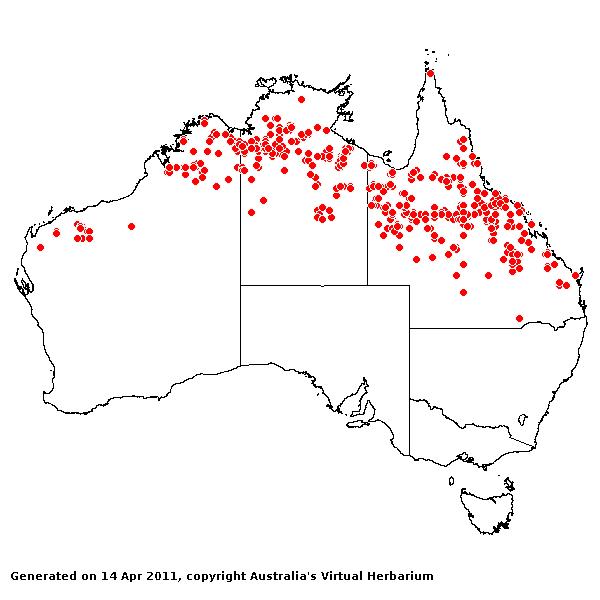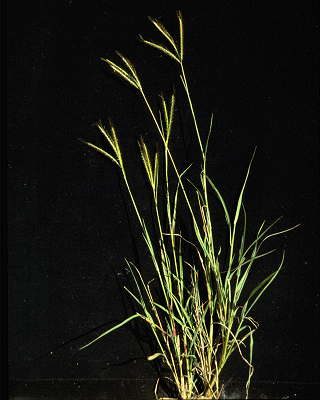Dichanthium fecundum S. T. Blake. Univ.
Queensland
Dept. Biol. Pap 2(3): 51 (1944).
Classification. (GPWG 2001) : Subfamily
Panicoideae. Andropogoneae.
Type of Basionym or
Protologue Information: IT: S.T. Blake 8337, 28 Mar 1935, Australia: Queensland: North Kennedy Dist.
(US-1865523).
Key references
(books and floras): [1952] C.A.Gardner, Flora of Western
Australia 1 Gramineae (326), [1969] E.E.Henty, Manual
Grasses New Guinea (69), [1981] M.Lazarides in J.Jessop (ed)., Flora
of Central Australia (488), [2002] D.Sharp & B.K.Simon, AusGrass,
Grasses of Australia.
Illustrations:
[1952] C.A.Gardner, Flora of Western
Australia 1 Gramineae (327, Pl. 95).
Habit.
Perennial. Culms erect or geniculately ascending, 60–150 cm tall, 3–4 -noded.
Mid-culm nodes bearded. Lateral branches sparsely branched. Leaf-sheaths
glabrous on surface. Ligule a fringed membrane, a ciliolate membrane, 0.5–1.5
mm long, abaxially hairy, truncate. Leaf-blades flat or revolute, 10–25 cm
long, 2–5 mm wide. Leaf-blade surface scaberulous, indumented.
Inflorescence.
Inflorescence solid or subdigitate, a rame, with ramose branches. Central
inflorescence axis 0–1.5 cm long. Rhachis fragile at the nodes.
Spikelets.
Spikelets sessile, 1 in the cluster. Companion spikelets pedicelled, 1 in the
cluster. Basal sterile spikelets well-developed, 4 in number. Companion
spikelets developed, male or male with a few bisexual, 5–6.5 mm long. Fertile
spikelets 2-flowered, the lower floret barren (rarely male), the upper fertile,
comprising 1 basal sterile florets, comprising 1 fertile floret(s), without
rachilla extension, elliptic or oblong or oblanceolate, dorsally compressed,
4–5.5 mm long.
Glumes. Glumes
dissimilar, firmer than fertile lemma. Lower glume oblong, cartilaginous,
without keels, 7–9 -nerved. Lower glume surface indumented. Upper glume
lanceolate, keeled, 1-keeled, 3 -nerved. Florets. Basal sterile florets
1, barren, without significant palea. Lemma of lower sterile floret hyaline.
Fertile lemma without
keel, 1 -nerved. Lemma apex entire, awned, 1 -awned. Median (principal) awn
apical, 15–28 mm long overall, with a twisted column. Palea absent. Anthers 3.
Grain 1.9–2.5 mm long.
Continental
Distribution: Tropical Asia and Australasia.
Australian
Distribution: Western Australia, Northern Territory, Queensland.
Western Australia: Gardner,
Fitzgerald, Hall. Canning, Fortescue, Carnarvon. Northern
Territory: Darwin & Gulf, Victoria River, Barkly Tableland, Central
Australia North. Queensland:
Burke, Burnett, Cook, Gregory North, Leichhardt, Maranoa, Mitchell, North
Kennedy, Port Curtis, South Kennedy, Wide
Bay.
Notes.
Widespread along stream banks, and riverflats and on black clay soils of
tropical Australia.
Extends to New Guinea.
Considered an excellent fodder grass. Flowers Dec.-Oct.





